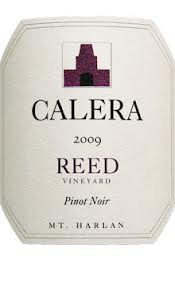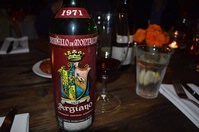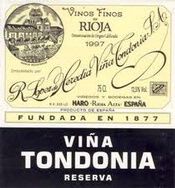|
|
 |
|
November 19, 2013
The beauty of the Thanksgiving feast from the perspective of the wine
enthusiast is versatility.
The traditional Thanksgiving bird with all the trimmings provides multiple
options for pairing with wine. The most obvious and oft repeated, of course, is
the match with Beaujolais, the soft red wine of Burgundy made from gamay noir.
 This fruit-driven red from France is versatile in its own right,
taking on the mixture of savory and sweet at the feasting table without losing a
beat. You could stick with the tried and true (good producers include Louis
Jadot, Joseph Drouhin and Georges Duboeuf) and be perfectly happy at the end of
the long Thanksgiving day. This fruit-driven red from France is versatile in its own right,
taking on the mixture of savory and sweet at the feasting table without losing a
beat. You could stick with the tried and true (good producers include Louis
Jadot, Joseph Drouhin and Georges Duboeuf) and be perfectly happy at the end of
the long Thanksgiving day.
Or you could eschew the tradition of drinking French on this distinctly
American holiday and look to other possibilities; and they need not be red, for
a roasted turkey is equally friendly to certain white wines.
I am fond of presenting an abundance of riches and allowing guests to choose
on their own. It wouldn't hurt to place two wine glasses at each setting, for
those who would dare to drink red and white at the same time, as I often do.
My preference in red wines for the Thanksgiving feast is inclined toward
older, earthier wines or young wines with soft tannins. I try to stay away from
young California cabernet sauvignon and Bordeaux, unless the wines have aged to
the point of mellowness. This pushes me in the direction of pinot noir (domestic
rather than French, which tends to be tannic) and Rhone-style blends,
particularly those with a fair amount of grenache, which typically lends a
bright red-fruit characteristic that I find works well with the sweet and savory
offerings at the Thanksgiving table.
A few of my favorite pinot noir producers are Alysian, Dutton Goldfield,
Calera, Merry Edwards, The Four Graces, Gary Farrell, Domaine Carneros and
MacPhail. All of the aforementioned make small batches of vineyard-specific
pinot noir that are sure bets to dazzle even the most discriminating wine
lovers. The choices on Rhone-style red blends are more limited, but one of the
most consistent over recent years is Eberle Winery's Cotes-du-Robles. The 2009
won a gold medal at the recent Sommelier Challenge International Wine
Competition, and it is a wine I regularly stock in my personal cellar.
 During the Thanksgiving feast, I generally reach for richer, more
full-bodied, complex white wines than I do for everyday consumption. The
Thanksgiving table also lends itself to whites that are a bit off dry, so
rieslings, which have more residual sugar than most table wines to balance
higher-than-usual acidity. During the Thanksgiving feast, I generally reach for richer, more
full-bodied, complex white wines than I do for everyday consumption. The
Thanksgiving table also lends itself to whites that are a bit off dry, so
rieslings, which have more residual sugar than most table wines to balance
higher-than-usual acidity.
Three domestic rieslings that are sure to please are Dr. Konstantin Frank
Reserve riesling from the Finger Lakes region of New York, and Smith-Madrone
riesling and Trefethen riesling, both from the Napa Valley. All three are
limited production wines that will require some effort to locate, so I recommend
doing a search at Wine-Searcher.com, an indispensable resource for finding wines
that are not mass produced and in wide distribution.
My go-to Chardonnay these days is Bouchaine, made in the Carneros district of
the Napa Valley by pioneering winemaker Mike Richmond. The beauty of the
Bouchaine Chardonnay is its impeccable balance, combining rich, ripe flavors
with firm structure. This excellent area for Chardonnay also gives us the
stellar Acacia Chardonnays.
Of course, these suggestions are merely guidelines and reflect my own
personal preferences. Your taste may well be different. And that's the beauty of
the Thanksgiving feast. Chances are, if there's a wine you are fond of drinking,
it will find a compatible match somewhere on the Thanksgiving table.
Posted by Robert Whitley at 2:52 PM
|
|
November 4, 2013

I was invited on a recent Saturday night to join my friend and colleague
Jeremy Parzen for dinner at a wine savvy local restaurant. Jeremy, a native
Californian who is fluent in Italian, writes the closely watched Do Bianchi wine
blog. The focus, as you might imagine, is on the wines of Italy.
We would
be joined on this evening by winemaker Paolo Cantele, one of the young lions of
the wine industry in the Puglia region of southern Italy. Everyone would bring
some wine to share, as is the custom. And our small group grew as the evening
wore on and the wine flowed.
I confess I was a bit nervous about my
contribution, apologizing in advance should the wine I chose be over the hill.
You may have heard that wine improves with age. That’s not always the case, and
even when it is, there comes a time when any wine is completely shot, devoid of
flavor and past the point of redemption.
I hoped for the best but feared
the worst as we pulled the cork on my bottle of 1971 Argiano Brunello di
Montalcino. When this wine was made, the producer was barely known outside the
boundaries of Tuscany. The only Brunello producer of world renown was Biondi
Santi. And there was serious doubt that many of the rustic wines of the era
would improve over time.
 As the cork came
out intact (at 42 years on, it would not have been a surprise if the cork had
crumbled) there was a sigh of relief around the table. The cork was in excellent
condition, always a good sign after four decades in the cellar. As the cork came
out intact (at 42 years on, it would not have been a surprise if the cork had
crumbled) there was a sigh of relief around the table. The cork was in excellent
condition, always a good sign after four decades in the cellar.
The first
glass was poured and all around we marveled at the bright color, for red wines
tend to lose color and brown around the edges with significant age. Based upon
the visual inspection, the wine appeared to be very much alive.
After a
few quick swirls for aeration came the smell test. There were no off aromas.
With a bit of air and a little time, it began to exhibit aromas of tart cherry
and nuances such as leather and spice. So far so good.
Finally, the taste
test. Despite its age, the Brunello had structure and tannic grip, with complex
savory elements on the palate and ever more intense fruit as it got more air. I
did a little fist pump. The wine was that good.
Not to be outdone,
someone produced a bottle of 2001 R. Lopez Heredia “Vina Tondonia” Rioja
Reserva; only 12 years old but a wine of legendary longevity. At my favorite
wine shop, this is the vintage of Vina Tondonia Reserva that is currently
available.
You would think this Rioja would show some signs of age: loss
of color, taming of its fruit profile, soft tannins. Instead, the color was
brilliant. On the palate the wine was remarkably fresh. The structure was bold
and firm.
It took me back to a recent time when I ordered a 1970 Vina
Tondonia Reserva from the wine list at another restaurant. It was decanted and
brought to the table, and my guests at dinner were convinced it was a “young”
wine.
Older wines are not for everyone, and they may not be for you. They
evolve over the years and the flavors change. Most wines sold today are consumed
within days, if not hours, of purchase. You get a blast of fruit and a blast of
alcohol and that’s just fine for most people. Nothing wrong with
that.
But if you are at all curious about profound wines for the ages and
can’t afford the high price of Bordeaux or Burgundy, you could do worse than
explore the possibilities presented by top-notch Brunello di Montalcino and
Rioja Reserva.
Then you too might be inclined to add a little fist pump
to your wine tasting experience.
Posted by Robert Whitley at 5:03 PM
|
|
 |
|